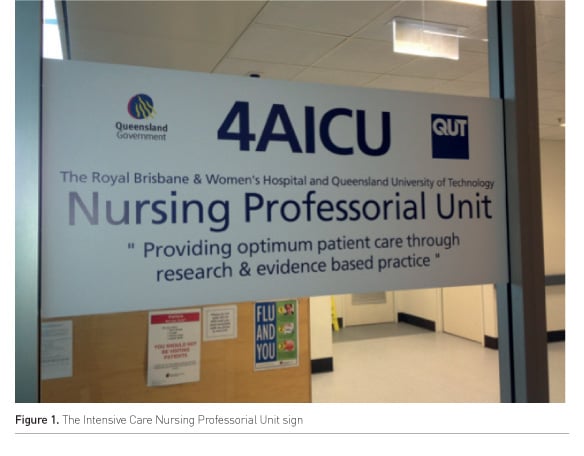ICU Management & Practice, Volume 17 - Issue 1, 2017
Advancing Research in the Intensive Care Unit via the Integration of a Nursing Professor
Advances in healthcare and management strategies for the critically ill patient continue to evolve at a rate that can become challenging for individual clinicians to keep abreast. It is crucial that medical, nursing and allied health professionals use an evidence-based practice (EBP) approach to support these advances and translate research evidence to practice. Barriers to research and EBP have been identified as lack of time, lack of authority, unsupportive organisational infrastructure, lack of access and lack of confidence in performing critical research appraisal (Hutchinson et al. 2006). Further, it has been highlighted that nursing research activity in the speciality of intensive care may be low in comparison to other disciplines such as medicine, and that generally nurses may be ill-prepared to be active consumers of research let alone undertake research studies (Bucknall et al. 2001; Makic et al. 2011; Smith et al. 2016). However, the days of respective disciplines working in silos are surely long over. It makes sense that different healthcare disciplines work together in a collaborative united manner to foster a unit culture of EBP and active research. Here, we outline the strategies undertaken in our intensive care unit (ICU) to ameliorate this challenge and highlight the positive outcomes we have achieved.
Background
The Royal Brisbane and Women’s Hospital (RBWH) is a major metropolitan quaternary public hospital in Queensland, Australia. The Intensive Care Services (ICS) in this hospital admit over 2400 patients per annum. The ICS consists of the intensive care unit (ICU) itself, plus outside services such as end-of-life consultations, central venous access line services, hospital-wide medical emergency responses and telemedicine outreach ward rounds. Patients admitted to the ICU are high acuity, and common medical diagnoses include: acute neurological disorders and trauma, respiratory diseases, renal dysfunction, burns, sepsis (including bone marrow transplant-related infections) and multi-trauma injuries. The unit is divided into four independent areas called pods, each with nine bed spaces. The operational capacity is 36 critically ill patients. However, one pod is allocated to short-stay, postoperative, high-dependency admissions and not included in the current funding for 26 ICU beds.
Supporting this sizeable ICS infrastructure is a large number of staff. The actual ICU is staffed with a Medical Director, who also serves as the ICS Director of Research, 10 Staff Specialists, 13 Senior Registrars and 21 Registrars. From a nursing perspective, the ICU is managed by an Assistant Director of Nursing, three Clinical Nurse Consultants (CNCs), two Nurse Managers and two Nurse Educators. There are approximately 204 registered nurses (RNs), who deliver, and are responsible for, complete patient care in a ratio of one registered nurse (RN) to one mechanically ventilated patient. There is a supernumerary CNC or Clinical Nurse-incharge of the ICU on each shift. Additionally, there is one supernumerary registered nurse (RN) acting as clinical coordinator in each pod for each shift across 24 hours and one registered nurse (RN) acting as clinical support who is also supernumerary and supports the bedside RNs across two pods. An additional RN is allocated to the medical emergency response team to attend emergencies throughout the hospital, but this role also provides additional ICU clinical support in the pods where most needed when not attending emergencies.
Challenges
The ICU nursing leadership group has long recognised the challenges in promoting EBP and an active research culture and has explored options to facilitate continued professional recognition and intellectual growth of nursing staff. Over time the ICU nursing team implemented a range of strategies and these included: expectations of research and EBP in nursing role development and position descriptions, monthly nursing research and education forums, journal club, engagement with a hospital-wide EBP training programme, localised quality improvement strategies leading to small research projects and conference presentations and local, national and international conferences. However, there was little nursing research emanating from this potentially fertile area.
The dilemma of how to progress an active and vibrant research culture in the ICS that must be effective and sustainable is ever present. The ICS at RBWH has a strong research focus, led by Professor Jeffrey Lipman, primarily through the Burns, Trauma, Critical Care Research Centre, School of Medicine, University of Queensland (btccrc.centre.uq.edu. au). This University Centre publishes over 100 peer-reviewed papers per year and has crossed the “usual” hierarchal domains of medicine, surgery, clinical pharmacy and physiotherapy by establishing and building cross-discipline collaborations. Historically, nursing research in the ICU began with a relationship with a university partner that centred primarily on postgraduate education i.e. critical care nursing certification. Up to 2011, small pockets of nursing research were undertaken; however, this was always under a model hampered and frustrated by insufficient resources, lack of funding, staffing, time and even acknowledgement.
Recognising these impediments, the ICU nursing leadership group was in accord that the ICU RNs were passionate about the quality of care they provided to critically ill patients, and would move towards a higher level of direct involvement in leading EBP and research in intensive care nursing care if adequately supported and mentored. This meant raising the bar in the intensive care nursing team to identify, support and drive intensive care nursing and multidisciplinary research.
See Also: Closer Collaboration Between Nurses and Physicians May Minimise VAP Risk
A Way Forward
The term professorial unit exists globally in the titles of many clinical and academic staff from a variety of departments e.g. Surgical Professorial Units, Professorial Unit of Surgery, Medical Professorial Unit etc. However, in reality what does this mean? Professor Glenn Gardner, inaugural Clinical Nursing Chair, Queensland University of Technology (QUT) and Director of the Centre for Clinical Nursing, RBWH, conceptualised and implemented the foundational nursing professional unit (NPU) over 12 years ago in a surgical ward at the RBWH. The NPU was established as an innovation to strengthen university/health service collaboration and to build and promote a clinical nursing research and EBP culture. There are now four successful QUT Nursing Professorial Units at the RBWH: kidney health, cancer services, mental health and intensive care.
Building on the NPU model founded by Professor Gardner, in late 2011 we established the Intensive Care Nursing Professorial Unit (ICNPU)—a unique collaboration with healthcare providers (ICS, RBWH) and academia (School of Nursing, Queensland University of Technology as the university partner). The QUT/RBWH ICNPU is a strategic direction to progress an active and vibrant intensive care nursing and multidisciplinary research programme in the nursing team. This model is a partnership between clinical nursing leadership, academic leadership and clinicians to advance the influence of high quality nursing care on patient outcomes. The ICNPU aims to provide high-level support for optimum continuing professional development of nurses and research to inform nursing practice in a specific clinical environment.
To achieve this the ICNPU supports the professional development of intensive care RNs through active engagement in EBP and research by:
- Developing an active intensive care nursing research culture within the service
- Demonstrating nurse-led research
- Developing research skills of intensive care nursing staff
- Creating opportunities for collaborative research projects (including multidisciplinary research)
- Providing mentorship for intensive care nurses undertaking tertiary studies
- Providing guidance and support for grant applications
At inception the ICNPU used an embedded scholar model whereby an academic (Professor of Nursing) was located in the ICU one day per week. The ICU provided infrastructure, support and access. This was an unfunded model with academic time provided as ‘in-kind’ by the university. We held a joint meeting of nursing leadership with Kidney Health Services to develop a vision statement. The ICNPU vision statement is “providing optimium patient care through research and evidence-based practice”. We placed the vision statement proudly on a sign at the entrance to the ICU (Figure 1), representing our commitment, and the collaborative organisations’ (QUT and RBWH) commitment, to ensuring this innovation is effective and sustainable. Further, we developed a strategic plan based on the three areas of continuing professional development, research and evidence-based practice. Each area has agreed goals, actions or activities and identified outcomes. The strategic plan is used to drive our goals and focus our achievements and is reviewed bi-annually.

In 2015, acknowledgement of our achievements culminated in the creation of the formal position of a full-time Professor of Nursing— jointly appointed and funded between RBWH and QUT – to lead the ICNPU. Further, we have established and implemented a Clinical Nurse Research position to progress EBP goals and work with the Professor of Nursing to drive clinical research. Professor Lipman conducts a weekly collaborative research meeting with research managers, clinicians (medical, nursing and allied health) and academics from three different universities to discuss issues and plan projects.
Thus far we have undertaken six completed clinical projects and trials, have a further seven trials or projects in progress, offered RNs oportunities to participate in research processes, recruited a number of RNs to higher degree research studies, achieved successful higher degree completions, and suported RNs in publishing and conference presentations. Specifically, we have completed a project to scope barriers and enablers to EBP in our ICU. This project will be used as the platform to further implement contextspecific EBP and research utilisation strategies for staff in our ICU.
Conclusion
An active research and EBP culture requires organisational commitment of resources, time and support. We have outlined one successful strategy, the creation of an Intensive Care Nursing Professorial Unit, led by a Professor of Nursing—jointly appointed by the hospital and university, and supported by a Clinical Nurse–Nursing Research, to build a strong culture of research in the ICU.
Abbreviations
EBP evidence-based practice
ICNPU Intensive Care Nursing Professorial Unit
ICS intensive care services
ICU intensive care unit
NPU nursing professorial unit
RN registered nurse





















